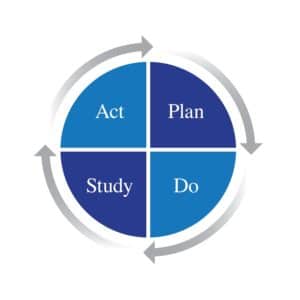 The PDSA Cycle (Plan-Do-Study-Act) is a systematic process for gaining valuable learning and knowledge for the continual improvement of a product, process, or service. Also known as the Deming Wheel, or Deming Cycle, this integrated learning - improvement model was first introduced to Dr. Deming by his mentor, Walter Shewhart of the famous Bell Laboratories in New York.
The PDSA Cycle (Plan-Do-Study-Act) is a systematic process for gaining valuable learning and knowledge for the continual improvement of a product, process, or service. Also known as the Deming Wheel, or Deming Cycle, this integrated learning - improvement model was first introduced to Dr. Deming by his mentor, Walter Shewhart of the famous Bell Laboratories in New York.
The cycle begins with the Plan step. This involves identifying a goal or purpose, formulating a theory, defining success metrics and putting a plan into action. These activities are followed by the Do step, in which the components of the plan are implemented, such as making a product. Next comes the Study step, where outcomes are monitored to test the validity of the plan for signs of progress and success, or problems and areas for improvement. The Act step closes the cycle, integrating the learning generated by the entire process, which can be used to adjust the goal, change methods, reformulate a theory altogether, or broaden the learning – improvement cycle from a small-scale experiment to a larger implementation Plan. These four steps can be repeated over and over as part of a never-ending cycle of continual learning and improvement.
PDSA and PDCA
Dr. Deming emphasized the PDSA Cycle, not the PDCA Cycle, with a third step emphasis on Study (S), not Check (C). Dr. Deming found that the focus on Check is more about the implementation of a change, with success or failure. His focus was on predicting the results of an improvement effort, studying the actual results, and comparing them to possibly revise the theory. He stressed that the need to develop new knowledge, from learning, is always guided by a theory. By comparison, the Check phase of the PDCA cycle focuses on the success or failure of a Plan, followed by needed corrections to the Plan in the event of failure. Click here to find an excellent article by Ron Moen and Cliff Norman, who offer a deeper explanation of the difference between the PDSA and PDCA Cycles.


